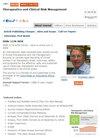老年2型糖尿病患者药物相关问题及健康相关生活质量评估
IF 2.8
3区 医学
Q1 Pharmacology, Toxicology and Pharmaceutics
引用次数: 0
摘要
研究目的:本研究旨在调查药物相关问题(Drug-related problems, DRPs)的患病率和预测因素,并评估DRPs对老年2型糖尿病患者健康相关生活质量的影响。方法:横断面研究进行了三个月的时间。研究纳入了2022年10月1日至2022年12月31日期间就诊糖尿病诊所的60岁及以上患者。数据通过结构化问卷收集,而实验室结果、用药记录、合并症和DRPs的后果则从电子病历中收集。使用PCNE V501分类系统对DRPs进行鉴定和分类。健康相关生活质量(HRQoL)采用经验证的EuroQol标准进行评估。结果:共纳入491例患者,患者平均年龄67.51岁(SD = 5.84岁)。女性患者占总受试者的52.34%。共有461人(约94%)经历了至少一次药物相关问题(DRP),每位患者的DRP从1到9不等,确定的DRP总数为1625个。最常见的DRP是药物选择问题,影响52.98%的患者。高用药频率、生活条件、糖尿病药物数量、合并症和吸烟等因素与较高的drp数量显著相关。研究发现,较高数量的drp会显著恶化患者的健康相关生活质量(HRQoL)。结论:老年2型糖尿病患者普遍存在drp,其中以药物选择问题最为常见,其次是剂量问题。导致这些drp的危险因素包括高用药频率、生活条件、大量糖尿病药物、多病和吸烟。此外,该研究得出结论,DRPs数量的增加与老年2型糖尿病患者HRQoL域的负面影响有关。关键词:药物相关问题,PCNE,老年病,糖尿病,多病,多药,健康相关生活质量,HRQoL本文章由计算机程序翻译,如有差异,请以英文原文为准。
Assessment of Drug-Related Problems and Health-Related Quality of Life Domains in Elderly Patients with Type 2 Diabetes Mellitus
Aims of the Study: This study aimed to investigate the prevalence and predictors of Drug-related problems (DRPs), as well as to evaluate the impact of DRPs on the health-related quality of life in geriatric patients with type 2 diabetes mellitus. Methodology: A cross-sectional study was conducted over a three-month period. Patients aged 60 years and older visited diabetes clinics from October 1, 2022, to December 31, 2022, were included in the study. Data were collected through structured questionnaires, whereas lab results, medication records, comorbidities, and the consequences of DRPs were collected from electronic medical records. DRPs were identified and classified using the PCNE V501 classification system. Health-related quality of life (HRQoL) was evaluated using the validated EuroQol criteria. Results: A total of 491 patients participated in the study, and the mean age of the patients was 67.51 years (SD = 5.84 years). Female patients represented 52.34% of total subjects. A total of 461 (around 94%) experienced at least one drug-related problem (DRP), ranging from one to nine DRPs per patient, with a total number of DRPs equal to 1625 identified. The most common DRP was the drug choice problem, affecting 52.98% of patients. Factors such as high drug frequency, living conditions, the number of diabetes medications, comorbidities, and smoking were significantly associated with higher numbers of DRPs. Higher numbers of DRPs were found to significantly worsen health-related quality of life (HRQoL) among patients. Conclusion: Geriatric individuals with type 2 diabetes mellitus encounter a significant prevalence of DRPs, with drug choice problems being the most common followed by dosing problems. Risk factors contributing to these DRPs include high drug frequency, living conditions, high number of diabetes medications, multimorbidity, and smoking. Also, the study concluded that the increased number of DRPs was associated with negative impact on HRQoL domains in geriatric patients with type 2 diabetes. Keywords: drug related problems, PCNE, geriatric, diabetes, multimorbidity, polypharmacy, health-related quality of life, HRQoL
求助全文
通过发布文献求助,成功后即可免费获取论文全文。
去求助
来源期刊

Therapeutics and Clinical Risk Management
HEALTH CARE SCIENCES & SERVICES-
CiteScore
5.30
自引率
3.60%
发文量
139
审稿时长
16 weeks
期刊介绍:
Therapeutics and Clinical Risk Management is an international, peer-reviewed journal of clinical therapeutics and risk management, focusing on concise rapid reporting of clinical studies in all therapeutic areas, outcomes, safety, and programs for the effective, safe, and sustained use of medicines, therapeutic and surgical interventions in all clinical areas.
The journal welcomes submissions covering original research, clinical and epidemiological studies, reviews, guidelines, expert opinion and commentary. The journal will consider case reports but only if they make a valuable and original contribution to the literature.
As of 18th March 2019, Therapeutics and Clinical Risk Management will no longer consider meta-analyses for publication.
The journal does not accept study protocols, animal-based or cell line-based studies.
 求助内容:
求助内容: 应助结果提醒方式:
应助结果提醒方式:


